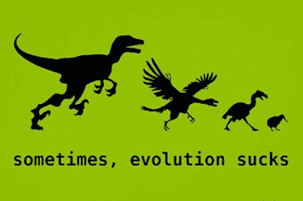The Paleontology of Intranets
It is a fact that the more controls you place on a system, the less likely people are to use that system. Information workers want to move quickly, consume data or share an idea on the fly. Some experts and pundits claim that Enterprise Content Management (ECM) is dead — that this vision of structured collaboration has failed because of its inability to win over these information workers. Of course, as you investigate the successful implementations of SharePoint and other platforms, it becomes readily  apparent that the drivers of success have more to do with up-front planning and proactive governance than whether or not technical needs are being met. If you design your platform to align with defined business goals, and ensure the voice of the customer (or the end user) is part of that design and build process, your chances of delivering a successful platform — embraced by your users — increases dramatically.
apparent that the drivers of success have more to do with up-front planning and proactive governance than whether or not technical needs are being met. If you design your platform to align with defined business goals, and ensure the voice of the customer (or the end user) is part of that design and build process, your chances of delivering a successful platform — embraced by your users — increases dramatically.
I first became familiar with the category of Knowledge Management (KM) back in the late 1990s as I became more involved with my organization’s knowledge base and intranet platforms, moving from managing just the front-end business intelligence (BI) tools to helping manage the expansion of our KM solutions, overall. KM platforms have existed for a couple decades, but historically they tend to be inflexible, silo-based collections of corporate data that are often tied to specific business processes. These structured collaboration systems get a bad rap, for the most part. In a world of self-service cloud and mobile applications, nobody wants to go to a centralized infrastructure to get their work done.
Within the past decade, many different collaboration platforms have sought to unlock these data silos, resulting in a vast array of options for structured and unstructured collaboration: the structured collaboration tools providing tighter control over and management of a company’s intellectual property, and unstructured tools providing more of the team-based communication and sharing features organizations need to get their work accomplished. At the forefront of this collaboration movement has been SharePoint, offering mostly structured collaboration, but also providing some unstructured and social capabilities as it has matured.
With the slow shift toward cloud-based platforms, we are now seeing the rise of the Enterprise Social Network (ESN), and with this rise, a push by many organizations toward the unstructured collaboration model as a way to improve the quantity and quality of employee collaboration. Microsoft’s acquisition of Yammer in 2012 for $1.2B was a testament to the rising influence of social within the enterprise, with McKinsey predicting that more than 75% of businesses would adopt an ESN in 2013 (the numbers have not yet come in on whether that came to pass, but I suspect the NSA leak and other security concerns may have driven that a bit lower than expected).
As a leader in unstructured collaboration, Yammer is helping Microsoft expand their leadership position within the social collaboration space not only through integrations with their SharePoint and Office365 platforms, but by helping Microsoft transition into a cloud-delivery model for many of the company’s most well-known products. Microsoft is betting on a future where all of us will lease, rather than buy our software, ensuring that we always have the latest, greatest version of their leading business and productivity solutions. But don’t think that it’s just Microsoft’s world-view at play — every major software maker is moving toward this model. But they also envision a world where social acts as a layer across all of our core applications (as a sort of “social fabric”), allowing individuals and teams to easily communicate and correlate activities across these systems.
The need for structured collaboration is not dead — far from it. Enterprises still need a way to safely manage their content and intellectual property, and SharePoint continues to have a strong future. But the reality is that ECM does not deliver the unstructured collaboration requirements of the end users. The release of SharePoint 2013 made huge strides to deliver an enterprise social experience, and the acquisition of Yammer has markedly accelerated delivery of that social collaboration vision. I’m interested to see how much further Microsoft pushes this combination with SharePoint SP1 coming in the spring, and with future releases of both SharePoint on premises and online.
However, the danger for the enterprise is complacency around metrics (visibility) and governance (control) — the idea that a new tool or platform will automatically solve end user adoption and engagement issues, and, more importantly, result in both improved productivity and business value. Nothing is automatic. Unstructured collaboration, like structured collaboration, needs to be aligned with business goals to be effective. If not aligned, ESNs and collaboration platforms alike will follow the same path as the intranet dinosaurs before them.





Truth be told, all those knowledge workers out there aren’t always so wild about using technology *at all* to get their work done. This is yet another one of the hidden secrets in ECM: people want to do their work their own way.
Evolution doesn’t go in a straight line; there are back eddies and side developments all the time. That’s also the case with real people trying to do real work. (I’ll ignore the clock punchers who just show up because they have to on this one.)
Sometimes a stack of note cards is the best “technology” out there. We can’t force people to use tools where it doesn’t make sense or work for them.
M.